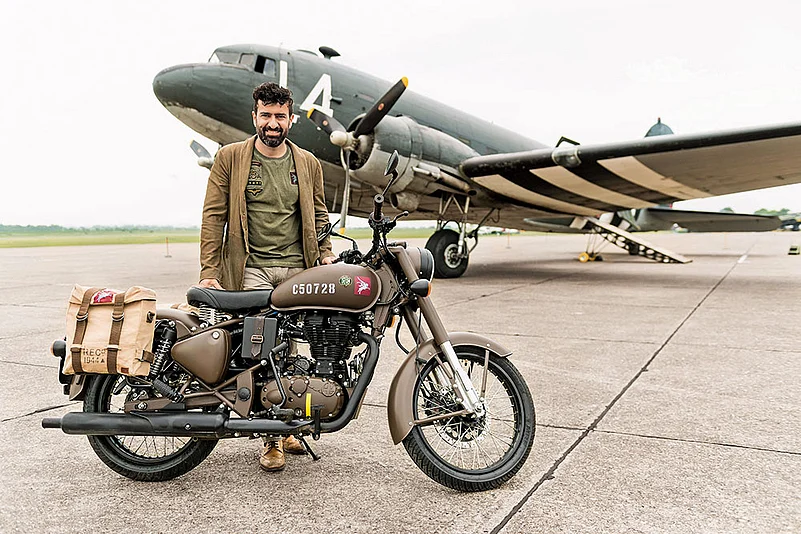When Ahmedabad-based Aesha Upadhyay entered her wedding mandap in 2016, she made several heads turn, including that of her groom, Laukik Vyas. Decked in bridal finery, she vroomed in on the Royal Enfield Bullet 350.
In 2011, actor and activist Gul Panag’s wedding procession included several Royal Enfield Bullet mobikes, while she sat in the sidecar of a modified Royal Enfield that her husband, pilot Rishi Attari, rode.
Cut to 2022. The sight of women riding the heavy-duty Royal Enfield motorcycles is becoming commonplace. In fact, the country is brimming with women-only Enfield biker clubs. The credit for that, to an extent, must go to Siddhartha Lal, managing director and chief executive officer (CEO) of Eicher Motors, the flagship company of the Eicher Group and manufacturer of the Royal Enfield motorcycles in India.
Incidentally, Lal, a self-confessed motorcycle boy, too rode one to his wedding as a testimony to his first love; a bright red Royal Enfield Machismo, which has been discontinued now.
Taking the Bull by the Horns
Before Lal joined the business and became Royal Enfield’s CEO in 2000, Vikram Lal, his father, had sent him to Europe to interact with the importers of Royal Enfield motorcycles. In one of his earlier interactions with Outlook Business, he had reminisced about that trip. “[A Swiss importer] was doing some amazing stuff with motorcycles, and his passion was so addictive that I ended up working with him as a mechanic in his garage!” Siddhartha Lal recalled.
However, it was only after taking over the business that the junior Lal realised that turning it profitable would not be an easy ride. The iconic 350 cc motorcycle brand, which sported a 1.5 hp Minerva engine on the steering head, was facing severe challenges, some of which were mechanical in nature, especially around the engine, while others were about business processes. For example, apart from product complaints about oil leakage and engine seizure, he had to also deal with issues like working capital crunch amid middling sales.
He got a new client servicing team in place after his dealers complained about the company being unresponsive to the issues raised by them. He leveraged his engineering knowledge to improve the motorcycle’s engine performance without impacting its signature thumping sound. Lal claimed that these steps yielded results and by 2004, the company’s annual two-wheeler sales had touched 25,000 units.
The launch of the Classic 350 in 2009 was an inflection point in the company’s history when volumes grew by around 22% CAGR between 2010 and 2018. Also, by 2010, the company had graduated to selling 50,000 units.
The Winning Strategy
One of the biggest strategy overhauls that Lal did was to bring down the number of businesses that Eicher was involved in. In 2005, he decided to sell 13 of the 15 divisions to focus only on two-wheeler verticals.
While his detractors thought that Lal was being foolhardy, he knew that focusing on the company’s core business was the best bet to succeed. He also wanted to make the motorcycles more contemporary with an oomph factor which would resonate with the youth. “All my relatives in the army rode a Bullet. Till a few years ago, I used to associate the brand with older riders,” says 22-year-old Aman Mehta, who recently bought the Hunter 350. “It is a fun ride for easy cruising,” he adds.
Automotive analyst Ranojoy Mukerji credits Lal for Royal Enfield’s dramatic turnaround. “He brought in many improvements, like relocation of the gear and brake pedals, more powerful models, new styling, etc. He just added a lot of sexiness to the machine. Suddenly, all those who saw themselves as ‘mature’ riders wanted a Bullet,” Mukerji adds. It became a status symbol and matter of pride that suddenly everybody who loved motorcycles wanted to own.
The success of the strategy got reflected in the company’s performance as well. In the quarter ended September 30, 2022, Royal Enfield sold 2,03,451 units, an increase of 64.7% from 1,23,515 motorcycles sold over the same period in FY22. In October 2022, the company clocked its highest-ever sales of its motorcycles in a month at 80,792 units and a growth of 79% over the same period last year.
Staying Sturdy
Despite the success, Lal believes that the company is still at a halfway mark and better things are yet to come. His hard work has not gone unnoticed though. At the annual general meeting in 2021, S. Sandilya, chairman of Eicher Motors, called Lal the architect of the company’s growth story over the last two decades.
“When he took over as the CEO of Royal Enfield in 2000, the division was making large losses and was slated for closure. Lal has transformed Royal Enfield into a formidable premium motorcycling brand in India, pioneering the leisure-riding segment,” said Sandilya.
In January 2021, Royal Enfield opened its first global flagship store in Tokyo, Japan. Industry observers claimed that this was a significant development for it, given that Japan is among the key motorcycling markets in the world. The company’s revenue share from international markets has grown more than five times over the last seven years, from Rs 147 crore in FY16 to Rs 1,732 crore in FY22.
Mukerji notes that in a market where greats like Harley-Davidson tried to play on the brand’s iconic status, the “Made in India” Royal Enfield created a whole new segment where it became a highly desirable motorcycle brand in India. Lal created a whole new brand of Royal Enfield, Mukerji avers, and that is where lies the importance of Siddhartha Lal in the company’s journey.

















